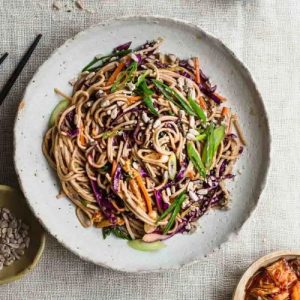
15-Minute Spicy Kimchi Salad with Noodles
A spicy, tangy, and crunchy vegan noodle salad loaded with fresh vegetables, kimchi, and a creamy tahini-sesame dressing. High in fiber, plant-based protein, and healthy fats, it’s a quick, satisfying meal perfect for lunch, dinner, or meal prep.
Equipment
- 1 large pot (for boiling noodles)
- 1 large mixing bowl
- 1 Whisk
- 1 Cutting board
- 1 Sharp Knife
- 1 Colander (for draining noodles)
Ingredients
For the Dressing:
- 1 clove garlic crushed
- ½ tablespoon fresh ginger finely grated
- 1½ tablespoon sesame oil
- 2 tablespoon tamari or soy sauce
- 2 tablespoon maple syrup or raw sugar
- 2 tablespoon rice vinegar
- 2 tablespoon tahini
- 1 teaspoon gochujang paste optional, or sriracha
- 2 tablespoon water
For the Salad:
- 270 grams soba noodles or 400 grams Hokkien/Udon noodles
- 1 large carrot peeled and julienned
- 2 –3 spring onions finely sliced on an angle
- 2½ cups cabbage thinly sliced
- ⅔ cup kimchi chopped
To Serve:
- ½ cup mixed seeds sunflower, pepitas, hemp
Instructions
- Prepare the Dressing – Garlic & Ginger Base: Start by making the salad dressing. Take one garlic clove and crush it finely, releasing its pungent aroma. Grate half a tablespoon of fresh ginger, ensuring it’s finely shredded to blend smoothly. In a medium mixing bowl, combine the garlic and ginger with 1½ tablespoons of sesame oil. Whisk these ingredients gently until they are well incorporated, forming the aromatic base of your dressing.
- Add the Liquid Flavors – Sweet, Savory & Tangy: Next, add the flavor boosters. Pour in 2 tablespoons of tamari or soy sauce for a savory depth, followed by 2 tablespoons of maple syrup (or raw sugar) to balance the saltiness with natural sweetness. Incorporate 2 tablespoons of rice vinegar for a subtle tang that will brighten the salad. Mix thoroughly using a whisk to create a smooth, cohesive liquid base.
- Creamy Element – Tahini & Spice: To enrich the dressing, add 2 tablespoons of tahini, which provides a nutty, creamy texture. If you enjoy a bit of heat, include 1 teaspoon of gochujang paste or sriracha, depending on your preferred spice level. Whisk again until all ingredients form a glossy, smooth emulsion. Add 2 tablespoons of water gradually to adjust the consistency to a pourable, yet rich texture. Set aside while you prepare the noodles and vegetables.
- Cook the Noodles – Boiling Perfection: Bring a large pot of water to a rolling boil over medium-high heat. Once boiling, add 270 grams of soba noodles (or 400 grams of Hokkien/Udon noodles if you prefer a heartier texture). Stir gently to prevent the noodles from sticking. Cook according to package instructions – typically around 4 minutes for soba. Taste a noodle to check doneness; it should be tender yet slightly firm (al dente).
- Chill the Noodles – Cold & Refreshing: Once cooked, drain the noodles into a colander. Immediately rinse them under cold running water to stop the cooking process and cool them completely. This step prevents sogginess and ensures the noodles maintain a firm texture. Shake the colander gently to remove excess water. You can also use a paper towel or clean kitchen cloth to pat them dry lightly.
- Prepare the Vegetables – Crisp & Colorful: While the noodles are cooling, prepare the fresh vegetables. Peel one large carrot and cut it into thin julienne strips for a crunchy texture. Wash 2½ cups of cabbage thoroughly, then slice it finely for a crisp bite. Trim and slice 2–3 spring onions on a diagonal to add a delicate, fresh onion flavor and visual appeal. Chop ⅔ cup of kimchi into small pieces, which will infuse the salad with its characteristic tangy and spicy flavor.
- Assemble the Salad – Layering Flavors: In a large mixing bowl, combine the prepared vegetables and kimchi. Add the chilled noodles on top. Pour the dressing over the salad gradually, tossing gently with tongs or salad forks to coat everything evenly. Ensure each strand of noodle and piece of vegetable is lightly covered with the flavorful dressing without becoming soggy.
- Garnish & Serve – Crunchy Finish: Finish the salad with a generous sprinkle of mixed seeds, such as sunflower, pepitas, and hemp seeds. These add a delightful crunch, healthy fats, and extra protein to the dish. Give the salad one final gentle toss to distribute the seeds evenly.
- Presentation – Ready to Enjoy: Transfer the salad into individual serving bowls or a large platter for sharing. Notice the vibrant colors of the vegetables, the glossy noodles, and the sprinkled seeds – a feast for both the eyes and the palate. Serve immediately for the freshest taste, or refrigerate for up to a day if preparing ahead.
- Tips & Variations – Personalize Your Salad: For added protein, consider adding cubed tofu or edamame. Swap soba noodles for rice noodles for a gluten-free option. Adjust the spiciness of the dressing to taste by adding more gochujang or a splash of sriracha. This salad also holds well for meal prep, making it an excellent choice for a quick, healthy lunch throughout the week.
Notes
- Use cold noodles for the best texture; this prevents them from becoming mushy in the salad.
- Adjust the level of spiciness by adding more or less gochujang or sriracha.
- Soba noodles offer a lighter, nuttier flavor, while Hokkien or Udon noodles give a more filling, chewy bite.
- For extra crunch, toast the seeds lightly before sprinkling on the salad.
- This salad is best eaten fresh but can be stored in the fridge for up to 24 hours.
- Feel free to swap vegetables based on seasonality or personal preference; bell peppers or cucumbers work beautifully.